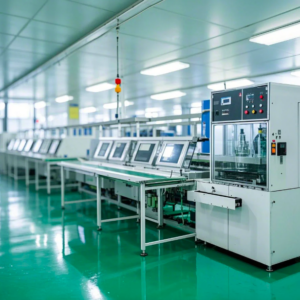A PCB handling conveyor is a crucial piece of equipment used in the electronics manufacturing industry, specifically for transporting printed circuit boards (PCBs) through various stages of the production process. These conveyors are designed to streamline the assembly, testing, and packaging of PCBs, ensuring high efficiency and precision. In this article, we’ll explore the functions, working principles, and common applications of PCB handling conveyors.

What is a PCB Handling Conveyor?
A PCB handling conveyor is a conveyor system designed specifically to transport PCBs throughout the production line. It provides a stable and controlled method for moving PCBs between different assembly or inspection stations, minimizing the risk of damage and improving overall workflow. The conveyors are typically equipped with features that ensure the PCBs are securely held in place during transport and are resistant to environmental factors like static electricity or vibration.
Working Principle of a PCB Handling Conveyor
The PCB handling conveyor works by using a belt or chain system that moves PCBs from one stage of production to another. Depending on the design of the system, the conveyor can be fitted with adjustable speeds, automated alignment features, and even robotic arms for more complex handling. The system is equipped with sensors that monitor the position of the PCBs to prevent jams or misalignments, ensuring smooth transport.
The conveyor’s structure is typically designed to be compatible with different PCB sizes and shapes, making it highly adaptable. The belt or chain moves in a continuous loop, which means that once a PCB is placed on the conveyor, it will be moved along the line automatically, reducing the need for manual intervention.
How Does a PCB Handling Conveyor Work in Practice?
In real-world applications, a PCB handling conveyor starts by receiving incoming PCBs from an upstream process, such as soldering or component placement. Once the PCB is placed on the conveyor, it moves along the line and can pass through inspection stations, cleaning stations, or reflow ovens. Each station is equipped with machinery that interacts with the PCBs to carry out specific tasks, such as quality checks, testing, or coating application.
The conveyor helps maintain the integrity of the PCBs by ensuring that they are securely supported and positioned correctly as they travel from one step to the next. The use of a PCB handling conveyor reduces human error and increases throughput, making the production process more efficient and less prone to defects.
Applications of PCB Handling Conveyors
PCB handling conveyors are used across a variety of industries, most notably in electronics manufacturing. They are commonly found in the production lines of companies that specialize in consumer electronics, telecommunications, automotive electronics, and other sectors that require precise PCB assembly. Some specific applications include:
- PCB Assembly Lines: To transport PCBs between different assembly stages, such as component placement, soldering, and testing.
- PCB Testing Stations: PCBs will be moved to automated testing equipment for quality control and defect detection.
- Cleaning and Coating Stations: To carry PCBs through washing or coating processes, ensuring no contamination or damage during cleaning.
- Packaging Lines: To move finished PCBs to the packaging area for shipment or storage.
Conclusion
A PCB handling conveyor plays a pivotal role in the efficient and safe movement of PCBs through various stages of manufacturing. With its ability to improve production speed, reduce errors, and maintain PCB integrity, it has become an indispensable tool in the electronics industry. Whether you’re assembling, testing, or packaging PCBs, a PCB handling conveyor can help optimize the workflow and ensure that each PCB is processed accurately and efficiently.
